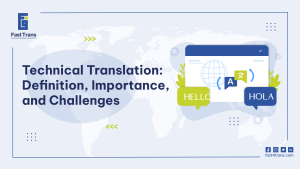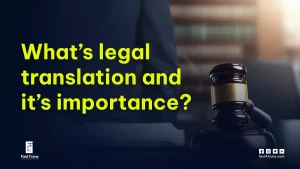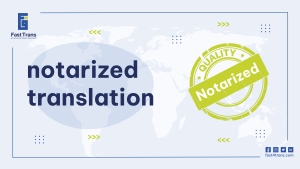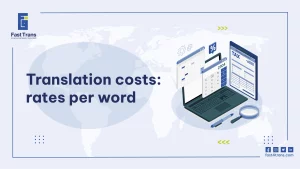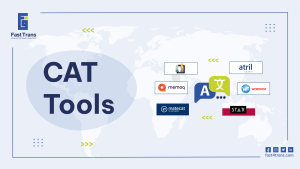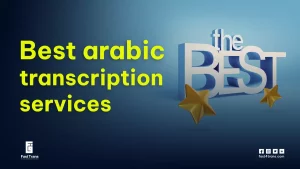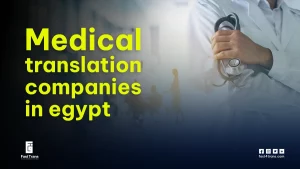You can think of translation as a one-way process that simply involves rendering a text from one language into another. However, there is more to this process that makes it go both ways!
Arabic back translation is a crucial process where a translated Arabic text is retranslated into the original language to ensure accuracy and cultural relevance. This technique helps businesses, especially in legal, medical, and technical fields, verify that their content aligns with both the original intent and local regulations. By involving native speakers and separate translators, it ensures that important documents or marketing materials are precise, culturally appropriate, and free from errors, making it essential for global brands aiming for clear communication in Arabic-speaking markets.
What is Arabic Back Translation?
Arabic back translation, also known as reverse translation, is the process of translating a text that has already been translated into Arabic back into the original source language. This technique is commonly used as a quality assurance measure to identify any discrepancies or deviations between the original and the translated text, helping to correct any errors or misunderstandings.
Arabic back translation serves as an essential quality control tool because it enables a comprehensive comparison of the original content with its Arabic version, ensuring the accuracy and appropriateness of the translation.
The process of Arabic back translation involves four main steps:
- The translator first translates the source text into Arabic.
- Another translator then translates the Arabic version back into the source language.
- A reconciliation process occurs where the differences between the initial translation and the back translation are analyzed and addressed.
- Finally, an evaluation of the reconciliation outcome takes place to ensure that the translation aligns with the original content.
What is reconciliation?
After the back translation is completed, reconciliation happens when the original translator defends their translation or suggests alternatives. The main goal of Arabic back translation is to identify differences between the two versions so that these discrepancies can be corrected in the Arabic translation, ensuring a more accurate and faithful rendering of the original text.
Arabic back translation vs. double translation
It’s important not to confuse Arabic back translation with double translation, even though they are sometimes used interchangeably. Double translation refers to a method where a translator creates multiple versions of a piece of content, offering alternative translations, while Arabic back translation focuses on verifying the accuracy of the Arabic translation by comparing it to the original text.
Why would you use the back translation method?
- Back translation is important for spotting mistakes in highly specialized technical texts like medical and legal ones.
- A Great way to solve inconsistencies or ambiguities in translation.
- Ensures a well-localized translation that translates cultural nuances perfectly.
- To adhere to compliance regulations.
- To preserve legal intent when it comes to legal texts.
- Building globally accessible content.
- Building trust and transparency of a business in an international market.
- It makes content sound customized and catered for audiences.
The best types of Arabic back-translated content
Not all types of translation need to be back-translated. Back translation could do more harm than benefit in some cases.
The best types of Arabic back-translated content include highly regulated areas like legal, technical, financial, and medical texts, ensuring compliance with local regulations. Creative content, such as marketing materials, also benefits from back-translation for cultural relevance and clarity in Arabic-speaking markets.
Highly regulated content:
- Legal content: contracts, insurance documents, and other legal texts should be back-translated to ensure they comply with local laws and regulations in Arabic-speaking regions.
- Technical content: back translation of user manuals, safety warnings, operating instruction manuals, and product descriptions ensures that the content is clear and accurate for Arabic-speaking users.
- Financial content: reports, bank statements, and stock market information must be translated and back-translated to ensure compliance with Arabic financial regulations.
- Medical content: protocols, drug information, pharmaceutical research, and patient records should be back-translated to guarantee accuracy and meet local health regulations in Arabic-speaking countries.
Creative content:
This is especially relevant to the marketing sector, and could include:
- Marketing slogans, advertisements, ad copies, and product labeling in Arabic. Back translation ensures that these creative materials are culturally appropriate, clear, and convey the intended message accurately in the target market.
By focusing on these types of Arabic back-translated content, you ensure higher accuracy and cultural appropriateness, which is crucial for successful communication in the Arabic-speaking world.
When to use Arabic back translation services?
- Hiring an additional translator to do reverse translation can double the cost of the project, yet reverse translation is needed when your business can’t afford inaccurate translations by any means.
- When the content belongs to a highly technical and regulated field, such as legal or medical documents, it becomes crucial to translate your content into Arabic in the most accurate way possible. The accuracy of these translations is essential to avoid misunderstandings and potential legal or health risks.
- When your content is very creative and highly important for the business, such as marketing materials or brand messaging, ensuring the right nuance and tone in Arabic is critical to retaining the intended impact.
When you don’t have to use Arabic back translation?
- You don’t have to reverse translate the whole document; you can be smart about which parts of paragraphs need to be double-checked. Focusing only on key sections that have the most significant impact can save time and resources.
- When other methods of quality assurance and proofreading will do the job. For many general or less critical documents, these methods can be effective enough without the added cost of back translation.
- When the content is literary or highly creative, such as poetry or fiction. Back translation could harm the essence of the source text instead of staying faithful to it. In these cases, a professional Arabic translator’s creativity and understanding of cultural nuances are more important than a literal reverse translation.
- When you can’t increase the project cost further by hiring an additional translator to do a back translation, it may be better to rely on other quality control measures that won’t add extra financial burden.
Who uses Arabic back translation?
Businesses operating in international markets and aiming to reach a wide Arabic-speaking audience often utilize back translation. A good example of this is how global slogans, like McDonald’s “I’m Lovin’ It,” are translated across different cultures.
In German, it’s translated as “Ich liebe es,” meaning “I love it.”
In Turkish, it’s “İşte Bunu Seviyorum,” which means “That’s what I like.”
In Arabic, the translation is “انا أحبه,” which means “I love it.”
However, Arabic back translation can sometimes reveal interesting nuances or errors. For example, when the slogan was translated into Chinese (wo jiu xihuan), back translation revealed a shift in meaning: “I like it no matter what you say,” which altered the original sentiment of the slogan.
This mistake was pointed out by Mark Cohen in his article titled “I’m Lovin’ It!” – A “Wrong Way” for McDonald’s?
Moreover, Arabic back translation is crucial in fields like medicine, pharmaceuticals, finance, and law, where regulatory standards demand that translations meet specific legal and technical requirements for the target region.
Creative back translation examples
Creative examples of back or reverse translation can be found all over the marketing field. When it comes to advertising, the translation of copies is often highly creative and strikes people as funny in some instances.
BMW’s Slogan
BMW’s slogan “Freude am Fahren” was translated to English as “sheer driving pleasure“. The back translation revealed to us that the English translation meant ‘Fahrvergnugen’ in German, or “driving enjoyment”.
KFC’s Slogan
A famous example of funny reverse translation is of KFC slogan
“Finger Lickin’ Good” was translated falsely into Chinese as “Eat Your Fingers Off“, which is an embarrassing error that could have been avoided with the use of a back translation.
Speak of the Devil
Recently, the Language Nerds community has published an interesting article about how the idiom “speaking of the devil” is said in different cultures.
In French: Speak of the wolf and he’s out of the woods/ Speak of the wolf, and there is its tail.
In Czech: Speak of the wolf.
In Arabic: When you mention the cat, it comes out jumping.
In Spanish: Speak of the King of Rome.
In Japanese: Speak of the devil and its shadow will appear.
In Italian: Speak of the devil and its shadow will appear.
Such a resource could come in handy when translating highly idiomatic content for businesses. When localizing content for a specific audience, it is extremely important to come prepared with such language differences across different regions.
Notice how the translation of this idiom is quite similar in Japanese, English, and Italian because they mention the ‘devil’.
While Czech and French share the analogy of the ‘wolf’.
Arabic Back translation best practices and recommendations
For effective Arabic back translation, use separate translators for accuracy, avoid showing the original text, and provide clear guidelines. Ensure cultural and linguistic precision by involving native speakers and reviewing translations with a focus on SEO-friendly terminology and context.
1. Use a Different Translator for Back Translation:
To avoid conflicts of interest, always assign a separate translator for the back translation process.
2. Don’t Show the Original Content:
Do not provide the back translator with the original Arabic text to eliminate any potential bias in their translation.
3. Provide Clear Guidelines and Context:
Make sure to provide the back translator with clear instructions, along with relevant context. This may include reference materials or glossaries to ensure consistency and accuracy.
4. Be Precise but Respect Grammar:
Ask the back translator to focus on accuracy and precision, but remind them not to force a word-for-word translation that may disrupt the grammatical structure of Arabic.
5. Compare the Back Translation Yourself:
Review the back translation and compare it to the original Arabic text to assess its accuracy. Alternatively, you can invite a third-party linguist with expertise in Arabic to help with the comparison.
6. Involve Native Arabic Speakers:
It’s crucial to involve native Arabic speakers who have a deep understanding of the cultural nuances and subtleties of the language.
7. Use Machine Translation Carefully:
While machine translation tools can be helpful, they are not flawless and can lead to significant errors, especially when reversing the translation. Always prefer human translators for back translation tasks.
8. Make a Checklist:
At the end of the back translation process, review key questions such as: Does the back translation accurately convey the meaning and tone of the source Arabic text? Are there any inconsistencies or areas that need adjustment? Is the terminology consistent? Are the grammar and punctuation correct? And, most importantly, are cultural nuances properly addressed?
How fast trans handles back translation
Now, Fast Trans, one of the leading translation companies in MENA, is here to assist you with high-quality and rock-bottom prices for back translation and transcreation services.
Our team of certified translators get the job done, whether you need any of your documents to be translated into the target language, or you want to hire a third party to handle your back translations.
Either way, Fast Trans has got you covered.
Conclusion
Arabic back translation, also known as reverse translation, is a process where an Arabic translation of a text is converted back into its original language. This technique is used to verify the accuracy and consistency of translations, particularly in fields like legal, medical, and technical content, ensuring compliance with regulations and cultural appropriateness. The process involves translating the text into Arabic, then back into the original language, followed by reconciliation to address any discrepancies and ensure alignment with the original message.
This method is particularly valuable for businesses aiming to reach Arabic-speaking audiences, ensuring that marketing, legal, and technical content is not only accurate but also resonates culturally. By employing native speakers and separate translators for back translation, businesses can achieve precise and effective translations that maintain the integrity of the original content. This approach helps to minimize errors, preserve legal intent, and ensure clarity in high-stakes industries like pharmaceuticals, finance, and law.


